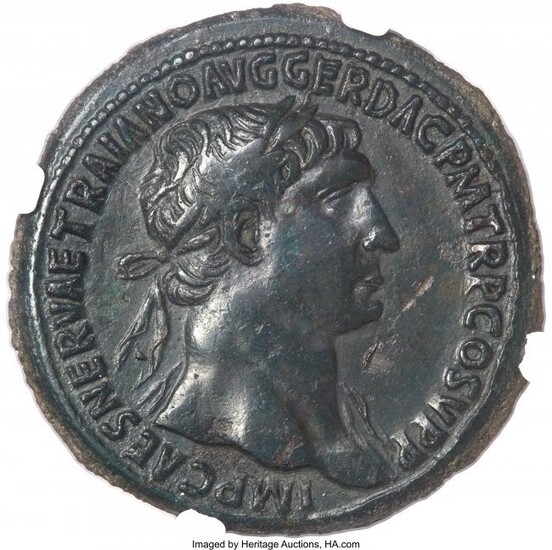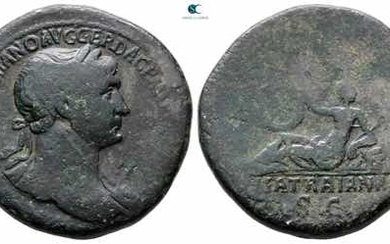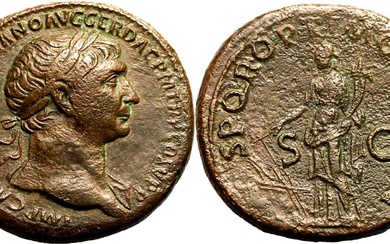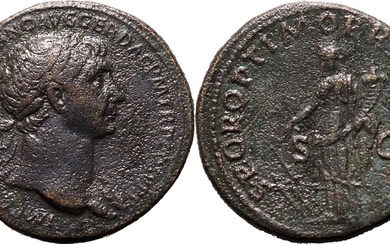30043: Trajan (AD 98-117). AE sestertius (35mm, 26.94 g
Trajan (AD 98-117). AE sestertius (35mm, 26.94 gm, 7h). NGC XF 5/5 - 2/5, Fine Style, smoothing. Rome, ca. AD 103-104. IMP CAES NERVAE TRAIANO AVG GER DAC P M TR P COS V P P, laureate bust of Trajan right, slight drapery on left shoulder / S•P•Q•R•OPTIMO PRINCIPI, view of the Circus Maximus, the exterior showing a colonnaded front with arch indicating gateway, surmounted by facing quadriga, similar arch with quadriga higher behind on right, another arch surmounted by quadriga facing right at left; the interior sides of the Circus not visible, the back is indicated by a sweep of colonnades and the pulvinar to the upper left, the center contains the great obelisk, flanked metae at either end of the spina with arches and statue between, being approached by two racing quadrigas existing the starting gates at right. RIC II 571 var. (aegis on left shoulder). Originally a pastoral valley between Rome's Aventine and Palatine Hills, the Circus Maximus became a racetrack and staging ground for public spectacles soon after Rome's founding circa 753 BC. A long oval track evolved, wide enough to accommodate four quadrigas running abreast. By the third century BC the central spina was in place, a set of starting gates had been added and wooden bleachers were erected partially around its 4,400-foot circuit. Julius Caesar rebuilt the lower tiers in stone and added an upper deck in wood. Pliny claimed the Circus could now accommodate 250,000 spectators but modern estimates top out at 150,000. At great expense, Augustus brought a towering Egyptian obelisk from Hieropolis and placed it at the center of the spina; he also added a high dais called a pulvinar for where the Imperial family could view the proceedings. A veritable city grew up around the Circus, including food stalls, shops, stables and housing; however the ramshackle wooden bleachers continued to represent a fire hazard until Trajan rebuilt the whole structure in stone circa AD 105-110. HID03101062020 © 2020 Heritage Auctions | All Rights Reserved
[ translate ]View it on
Estimate
Time, Location
Auction House
Trajan (AD 98-117). AE sestertius (35mm, 26.94 gm, 7h). NGC XF 5/5 - 2/5, Fine Style, smoothing. Rome, ca. AD 103-104. IMP CAES NERVAE TRAIANO AVG GER DAC P M TR P COS V P P, laureate bust of Trajan right, slight drapery on left shoulder / S•P•Q•R•OPTIMO PRINCIPI, view of the Circus Maximus, the exterior showing a colonnaded front with arch indicating gateway, surmounted by facing quadriga, similar arch with quadriga higher behind on right, another arch surmounted by quadriga facing right at left; the interior sides of the Circus not visible, the back is indicated by a sweep of colonnades and the pulvinar to the upper left, the center contains the great obelisk, flanked metae at either end of the spina with arches and statue between, being approached by two racing quadrigas existing the starting gates at right. RIC II 571 var. (aegis on left shoulder). Originally a pastoral valley between Rome's Aventine and Palatine Hills, the Circus Maximus became a racetrack and staging ground for public spectacles soon after Rome's founding circa 753 BC. A long oval track evolved, wide enough to accommodate four quadrigas running abreast. By the third century BC the central spina was in place, a set of starting gates had been added and wooden bleachers were erected partially around its 4,400-foot circuit. Julius Caesar rebuilt the lower tiers in stone and added an upper deck in wood. Pliny claimed the Circus could now accommodate 250,000 spectators but modern estimates top out at 150,000. At great expense, Augustus brought a towering Egyptian obelisk from Hieropolis and placed it at the center of the spina; he also added a high dais called a pulvinar for where the Imperial family could view the proceedings. A veritable city grew up around the Circus, including food stalls, shops, stables and housing; however the ramshackle wooden bleachers continued to represent a fire hazard until Trajan rebuilt the whole structure in stone circa AD 105-110. HID03101062020 © 2020 Heritage Auctions | All Rights Reserved
[ translate ]






